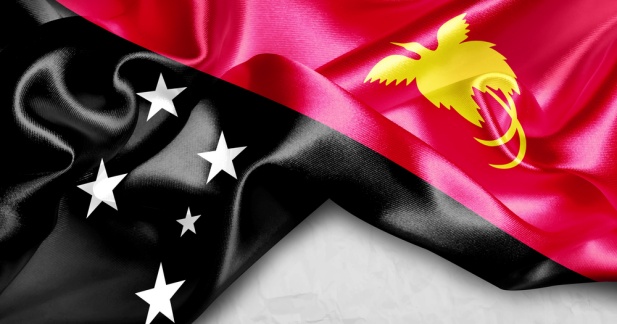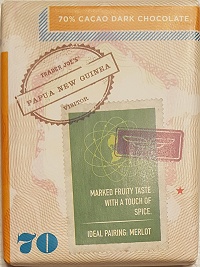
Trader Joe’s Chocolate Passport – Papua New Guinea 70%
March 20, 2017
Chocolate of the week: Papua New Guinea
Papua New Guinea (PNG) is located in the southwestern Pacific Ocean and occupies the eastern half of the island of New Guinea.
Chocolates made from the local cocoa beans are somewhat hard to find because the volume of cacao grown and exported from PNG is pretty low compared to other cacao growing nations.
Papua New Guinea’s cacao crop is currently recovering from massive devastation from a pest called the cocoa pod borer. In some regions of the country, exports have fallen 80%. Most cocoa farmers have left their plantations and looked for work elsewhere.
The cocoa pod borer (CPB) is a major pest to cacao. It’s easily spread and hard to control. The CPB damages the pod (fruit) of the cocoa tree therefore causing significant drops in yield and quality. Lots of effort has gone into eradicating the CPB and reviving the cacao plantings. It’s slow going, but things are improving.
Passport Papua New Guinea - The Taste Experience
 After learning about how precious chocolate sourced from Papua New Guinea is, I’m hoping for the best when I begin to eat the Papua New Guinea 70% dark chocolate bar from Trader Joe's Passport collection.
After learning about how precious chocolate sourced from Papua New Guinea is, I’m hoping for the best when I begin to eat the Papua New Guinea 70% dark chocolate bar from Trader Joe's Passport collection.
The aroma is smoky and earthy with notes of wood and leather. The predominate flavors to hit me as I take the first bite are smoke, ripe fruit, and deep roasted cocoa notes.
The ripe fruit and roasted cocoa notes are quickly replaced by an increased bitterness to the cocoa flavor with a hint of vanilla and spice toward the end. There’s a smoky finish.
The smokiness is most likely due to a traditional drying process the PNG farmers use rather than a native flavor coming through the bean. Let me explain.
Cacao Drying Process
There are two methods for drying cacao beans; sun drying and artificial drying.
Cocoa beans are dried after harvesting and fermenting. This process drives off moisture and reduces the water content within the bean. Drying is beneficial for transportation because it prevents fungus and yeast from growing on the beans and destroying them while being shipped to the manufacturer.
The best drying process is sun drying. The flavor development is at a critical point while drying, so taking it slow (about one week) and natural is superior. During sun drying, cocoa beans are spread out on concrete floors. They are raked, or turned over, to make sure drying is uniform.
Artificial drying can use different types of mechanical dryers (convection or conduction), or it can be done over large, burning fires.
Fire dried beans will absorb the flavor of smoke during this type of drying process. That is the principal reason why the Papua New Guinea chocolate has a touch of smoke flavor. Perhaps this flavor is not wrong or bad in the chocolate, but it is not part of the terroir of the bean.
Final Analysis
I’m not a huge fan of smoke flavor in chocolate. In my humble opinion, I consider it to be an “off-flavor”. Therefore, I am ranking this chocolate as good, but not as good as my number one pick, the Venezuelan 70%. It still ranks supreme!
Next up: São Tomé.
 Want More Chocolate Tasting?
Want More Chocolate Tasting?
You can join us right now. Learn all about chocolate tasting with milk chocolates, dark chocolates, even white chocolate. Refine your taste buds with expert guidance.
 Relax with Chocolate and Wine
Relax with Chocolate and Wine
The CUO Chocolate and Wine Tasting Guide will show you how to pair chocolate and wine for amazing experiences of your own or with friends!
The package from this Papua New Guinea chocolate suggests pairing with Merlot.
- BarkThins Dark Chocolate Coconut with Almonds - May 22, 2020
- Endangered Species Cacao Nibs + Dark Chocolate Review - May 15, 2020
- Mr. Dot Bar Review - May 7, 2020

